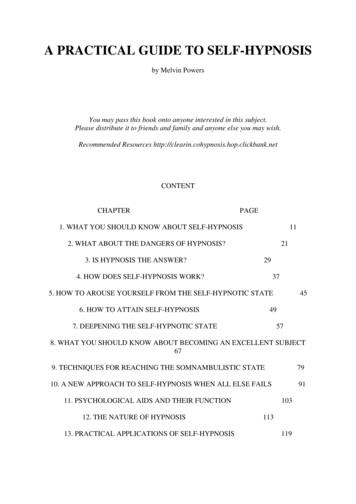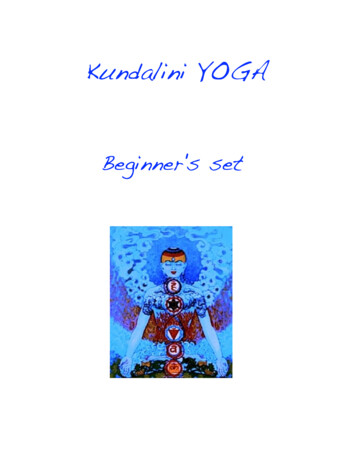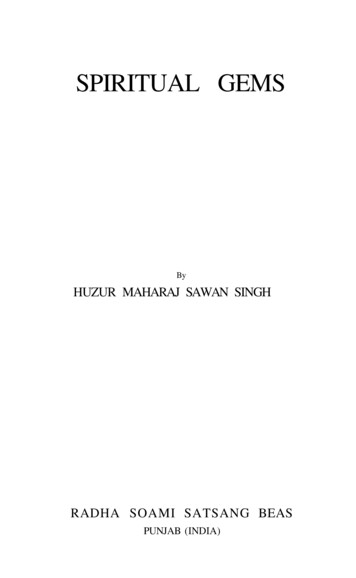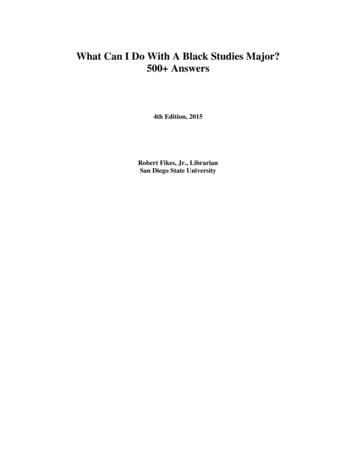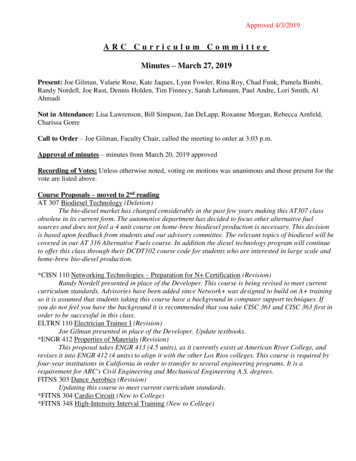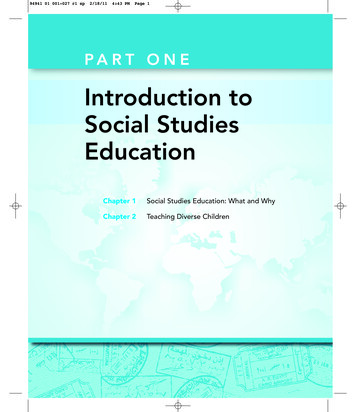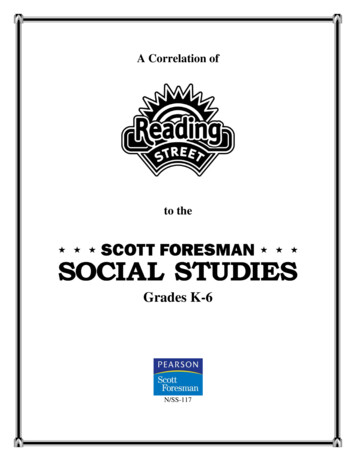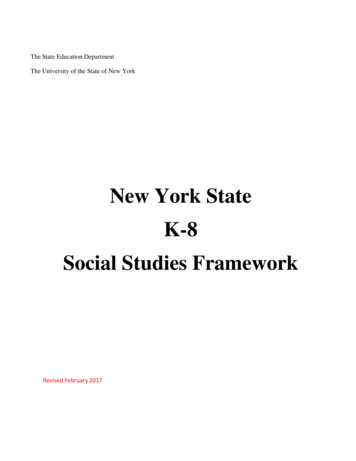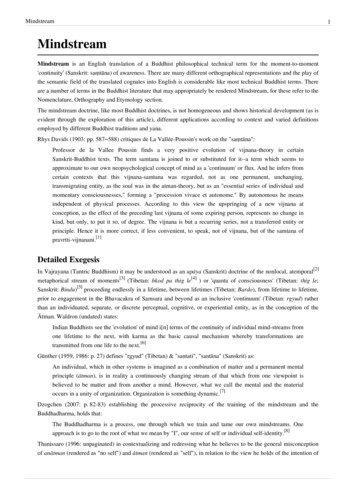
Transcription
MindstreamMindstreamMindstream is an English translation of a Buddhist philosophical technical term for the moment-to-moment'continuity' (Sanskrit: saṃtāna) of awareness. There are many different orthographical representations and the play ofthe semantic field of the translated cognates into English is considerable like most technical Buddhist terms. Thereare a number of terms in the Buddhist literature that may appropriately be rendered Mindstream, for these refer to theNomenclature, Orthography and Etymology section.The mindstream doctrine, like most Buddhist doctrines, is not homogeneous and shows historical development (as isevident through the exploration of this article), different applications according to context and varied definitionsemployed by different Buddhist traditions and yana.Rhys Davids (1903: pp. 587–588) critiques de La Vallée-Poussin's work on the "saṃtāna":Professor de la Vallee Poussin finds a very positive evolution of vijnana-theory in certainSanskrit-Buddhist texts. The term samtana is joined to or substituted for it--a term which seems toapproximate to our own neopsychological concept of mind as a 'continuum' or flux. And he infers fromcertain contexts that this vijnana-samtana was regarded, not as one permanent, unchanging,transmigrating entity, as the soul was in the atman-theory, but as an "essential series of individual andmomentary consciousnesses," forming a "procession vivace et autonome." By autonomous he meansindependent of physical processes. According to this view the upspringing of a new vijnana atconception, as the effect of the preceding last vijnana of some expiring person, represents no change inkind, but only, to put it so, of degree. The vijnana is but a recurring series, not a transferred entity orprinciple. Hence it is more correct, if less convenient, to speak, not of vijnana, but of the samtana ofpravrtti-vijnanani.[1]Detailed ExegesisIn Vajrayana (Tantric Buddhism) it may be understood as an upāya (Sanskrit) doctrine of the nonlocal, atemporal[2]metaphorical stream of moments[3] (Tibetan: bkod pa thig le[4] ) or 'quanta of consciousness' (Tibetan: thig le;Sanskrit: Bindu)[5] proceeding endlessly in a lifetime, between lifetimes (Tibetan: Bardo), from lifetime to lifetime,prior to engagement in the Bhavacakra of Samsara and beyond as an inclusive 'continuum' (Tibetan: rgyud) ratherthan an individuated, separate, or discrete perceptual, cognitive, or experiential entity, as in the conception of theĀtman. Waldron (undated) states:Indian Buddhists see the 'evolution' of mind i[n] terms of the continuity of individual mind-streams fromone lifetime to the next, with karma as the basic causal mechanism whereby transformations aretransmitted from one life to the next.[6]Günther (1959, 1986: p. 27) defines "rgyud" (Tibetan) & "santati", "santāna" (Sanskrit) as:An individual, which in other systems is imagined as a combination of matter and a permanent mentalprinciple (ātman), is in reality a continuously changing stream of that which from one viewpoint isbelieved to be matter and from another a mind. However, what we call the mental and the materialoccurs in a unity of organization. Organization is something dynamic.[7]Dzogchen (2007: p. 82-83) establishing the processive reciprocity of the training of the mindstream and theBuddhadharma, holds that:The Buddhadharma is a process, one through which we train and tame our own mindstreams. Oneapproach is to go to the root of what we mean by "I", our sense of self or individual self-identity.[8]Thanissaro (1996: unpaginated) in contextualizing and redressing what he believes to be the general misconceptionof anātman (rendered as "no self") and ātman (rendered as "self"), in relation to the view he holds of the intention of1
MindstreamShakyamuni, states:.the Buddha was asked point-blank whether or not there was a self, he refused to answer. When laterasked why, he said that to hold either that there is a self or that there is no self is to fall into extremeforms of wrong view that make the path of Buddhist practice impossible.[9]This clear evocation of what later became canonized in Buddhist discourse as Madhyamika or "middle way", is keyto tender a description of the ineffable Mysterium Magnum of the "Great Continuum" that is rendered in English as"Mindstream": the nondual interpenetration of ātman and anātman. This 'interpenetration' or 'coalescence' (Wylie:zung 'jug; Sanskrit: yuganaddha) is just a conceptual formation and technically, the "mindstream" is subject to theShakyamuni Buddha's 'Fourfold Reasoning' developed by Nargajuna and known as the Catuṣkoti though themindstream secures its nomenclature from the fourth pada "neither one nor many" (Wylie: gcig du 'bral ba'i gtantshigs), as this historically is the preferred subtle reification, but reification nonetheless.In the entwined Dzogchen traditions of Bönpo and Nyingmapa, the Mindstream is constituted by a continuum ofgankyil composed of the Five Pure Lights of the Five Wisdoms which unite the trikaya. These 'tantric correlations'(or Twilight Language) are evident in the iconographic representation of the Five Jinas[10] and the saṃpanna-kramaof the gankyil and mandala in Dzogchen sādhana. The 'supreme siddhi' or 'absolute bodhicitta' of the Dzogchenpa iswhen the Mindstream of their 'bodymind' (a rendering of namarupa) is 'released' (a rendering of Nirvana) as theRainbow Body.Capriles (2004: p. 35) defines the 'consciousness of the base-of-all' (Skt., alayavijñana; Tib., kunzhi namshee) ascongruent with the 'Mindstream' (Skt., santana; Tib., gyü) and mentions vasanas, bijas, and tathata:The consciousness of the base-of-all was not conceived as an immutable absolute, which is how theAtman of Hinduism is described; in agreement with the Hinayana idea of a succession of instants ofknowledge, it was explained as a continually changing stream of consciousness (Skt., santana; Tib.,gyü), and was said to be the vehicle that carries the karmic imprints (vasanas or bijas) that go from onelife to the next. In turn, from the standpoint of experience, the consciousness of the base-of-all is anample condition that yogis may find by absorption. Though the consciousness of the base-of-all is of thenature of thatness (Skt., tathata; Tib., dezhinnyia)—the absolute nature that is the single constituent ofall entities—this consciousness is also the root of samsara.[11]NameThe nomenclature and etymology of the Mindstream (Tibetan: dam pa'i byin rlabs or sems-rgyud; Sanskrit:citta-santāna) is convoluted and tied to: the historical context of Buddhism in India; the historical development ofBuddhism; the Silk Road transmission of Buddhism, the syncretic and dialogic doctrinal development of Buddhism;and to the secession of Buddhism from, and its persistent entwining relationship with, Sanatana Dharma and otherDharmic traditions, Chinese religions and Bön.Xin xiangxu 心相續 (Chinese)The Chinese translation of Sanskrit citta-saṃtāna and Tibetan sems kyi rgyud "mindstream" is xin xiangxu(simplified Chinese: 心相续; traditional Chinese: 心相續; pinyin: xīn xiāngxù; Wade-Giles: hsin hsiang-hsü). Thiscompound combines xin 心 "heart; mind; thought; conscience; core" and xiangxu "succeed each other", with xiang相 ”each other; one another; mutual; reciprocal" and xu 續 or 续 "continue; carry on; succeed". Thus it means"thoughts mutually succeeding each other".According to the Digital Dictionary of Buddhism, xīn xiāngxù 心相續 "continuance of the mental stream" (fromSanskrit citta-saṃtāna or citta-saṃtati) contrasts with wú xiàngxù 無相續 "no continuity of the mental stream"(from asaṃtāna or asaṃdhi) and shì xiāngxù 識相續 "stream of consciousness" (from vijñāna-saṃtāna).2
MindstreamThis Chinese Buddhist term xin xiangxu 心相續 "mindstream" is pronounced sim sangsok in Korean and shinsōzoku in Japanese.Citta-saṃtāna (Sanskrit)Citta (Sanskrit) holds the semantic field of "that which is conscious", "the act of mental apprehension known asordinary consciousness", "the conventional and relative mind/heart".[12] Citta has two aspects: ".Its two aspects are'attending to,' and, 'collecting' of impressions or traces (Sanskrit: vāsanā) cf. vijñāna."[12] Citta is often rendered as"sems" in Tibetan.Saṃtāna or Santāna (Sanskrit) holds the semantic field of "eternal", "continuum", "a series of momentary events","life-stream".[12]In the Sanskrit language, citta-santāna may be parsed as per the analyses of Keown, et al. (2003: p. 62) who state:Literally, "the stream of mind", a general term used to indicate the continuity of the personality of anindividual in the absence of the permanently abiding 'self' (ātman) that Buddhism denies."[13]dam pa'i byin rlabs (Tibetan)In the Tibetan language, dam pa'i byin rlabs may be parsed into dam pa'i which contains the semantic field of"flow", "stream"; whilst the semantic field of byin rlabs (Tibetan; Sanskrit: adhiṣṭhāna) holds "blessing", "sacred","empowerment", "inspiration" thus entwined constitute the "empowering flow from the sacred" which aretransmitted in the mindstream as well as synonymous with bodhichitta and enlightened mind and the mindstream inits ever-refining purity.Sems-rgyud or sems kyi rgyud (Tibetan)The Tibetan term rgyud holds the semantic field of "continuum", "stream", and "thread". Interestingly, it is the termthat Tibetan 'translators' (Tibetan: lotsawa) employed to translate and render the Sanskrit term "tantra".[14]Thugs-rgyud (Tibetan)[15]Thugs-rgyud may be parsed into "thugs" and "rgyud".Please refer above for "rgyud". Thugs holds the semantic field: "Buddha-mind", "(enlightened) mind", "mind","soul", "spirit", "purpose", "intention", "unbiased perspective", "spirituality", "responsiveness", "spiritualsignificance", "awareness", "primordial (state, experience)", "enlightened mind", "heart", "breast", "feelings" and issometimes a homonym of "citta" (Sanskrit).[16]Thugs-rgyud holds the semantic field and has been rendered into English as: "wisdom", "transmission", "heart-mindcontinuum", "mind", "[continuum/ stream of] mind", "nature of mind" and is a homonym for "sems rgyud" or"rgyud".[15]3
MindstreamMental continuumBerzin (2007) identifies "mental continuum" as Tibetan: sems-rgyud and Sanskrit: "santana".[17]Mental "stream" metaphorsThe metaphorical use of "stream" to describe mentality is endemic but not unique to Buddhist literature andworldview. In English for example, "stream of consciousness" is more familiar than "mindstream". Lachs andTalisse (2008:737) write,The "stream" or "flow" metaphor can be found in descriptions of mind and reality dating back to anumber of ancient sources, including the fragments attributed to the presocratic thinker Heraclitus, theUpanishadic writings of the Hindu canon, and various Buddhist and Taoist texts and commentaries.However, it was the American psychologist and philosopher William James who gave the express acertain technical significance and galvanized its contemporary usage.[18]James promoted the 'stream of consciousness' with its particular nomenclature, some state drawn from Bain (referfollowing), whilst immersed in Buddhist studies and accompanying protracted spiritual discipline of Vipaśyanā(Sanskrit), as related by Wallace (2003: p.6):Buddhologist Roger R. Jackson similarly portrays Buddhist meditation as a type of ritual act (Jackson1999:231). While such characterizations are certainly valid for some types of Buddhist meditation, theyare profoundly misleading for the practices of meditative quiescence (samatha) and contemplativeinsight (vipasyana), which are the two core modes of Buddhist meditative training. Techniques ofmeditative quiescence entail the rigorous cultivation of attentional stability and vividness, methodshaving a strong bearing on William James’s psychological theories of attention (Wallace 1998,1999a).[19]BuddhismThere are two entwined mindstreams according to the Two Truths, the absolute and relative, that are ultimatelynon-dual according to Atiyoga. The Divine Mindstream of 'consciousness' which is engaged in the phowa sadhana,for example; and the mindstream of thought, ideation (Tibetan: sem; Sanskrit: manas) (vṛtti-citta[20] ).Gyatso, Jinpa & Wallace (2003: p. 97) identify two kinds of consciousness continuum and associate the most subtlestate of consciousness continuum, elsewhere identified within this Wikipedia article as the 'mindstream substrate'with what is known in Tibetan Buddhist, Dzogchen and Bonpo discourse as 'clear light':In Vajrayāna Buddhism the subtlest state of consciousness is known as clear light. In terms of categoriesof consciousness, there is one type of consciousness that consists of a permanent stream or an unendingcontinuity and there are other forms of consciousness whose continuum comes to an end. Both theselevels of consciousness - one consisting of an endless continuum and the other of a finite continuum have a momentary nature. That is to say, they arise from moment to moment, and they are constantly ina state of flux. So the permanence of the first kind is only in terms of its continuum. The subtlestconsciousness consists of such an eternal continuum, while the streams of the grosser states ofconsciousness do end.[21]Sogyal (1994: p. 73) frames the importance of the stream metaphor in relation to meditation and the nature of mind,the objective of meditative sadhana:In the ancient meditation instructions, it is said that at the beginning thoughts will arrive one on top ofanother, uninterrupted, like a steep mountain waterfall. Gradually, as you perfect meditation, thoughtsbecome like the water in a deep, narrow gorge, then a great river slowly winding its way down to thesea, and finally the mind becomes like a still and placid ocean, ruffled by only the occasional ripple orwave.[22]4
MindstreamAs Bucknell et al. (1986: p. 112-113) in linking Tipiṭaka, Mahāmudrā and David-Néel state:In Buddhist literature the mental condition in which sequences of imagery and verbalizing run onendlessly is often compared to a flowing stream. We find in the oldest section of the Tipiṭaka the term'stream of consciousness' (viññāṇa-sotaṃ).[23] The same metaphor is often found in the Tibetanliterature. The guru Padma Karpo spoke of 'thoughts.following one after the other as if in a continuousstream';[24] Mipham Nampar Gyalba observed that the 'stream of images flows unbroken';[25] and in theVow of Mahāmudrā, there is reference to 'the mind river'.[26] This manner of speaking is also commonat the present day. Tarthang Tülku refers to 'the stream of mental images'[27] and 'the flow of thoughtsand images';[28] and David-Neel, in a discussion of the meditation practices she observed in Tibet,speaks of 'the continual, swift, flowing stream of thoughts and mental images.'[29]PsychologyStream of consciousness was coined by the philosopher Bain in 1855 and later popularized by the psychologistJames. Bain wrote, "The concurrence of Sensations in one common stream of consciousness, — on the same cerebralhighway, — enables those of different senses to be associated as readily as the sensations of the same sense."[30]After originating in psychological theory, the "stream of consciousness" metaphor became more common in Englishusage, and was adapted into different contexts, for instance, the stream of consciousness (narrative mode) in literarycriticism.James' classic 1890 The Principles of Psychology used several "stream" metaphors . Chapter 9, "The Stream ofThought" describes "the stream of consciousness" as constantly changing and "sensibly continuous":Consciousness, then, does not appear to itself chopped up in bits. Such words as 'chain' or 'train' do notdescribe it fitly as it presents itself in the first instance. It is nothing jointed; it flows. A 'river' or a'stream' are the metaphors by which it is most naturally described. In talking of it hereafter, let us call itthe stream of thought, of consciousness, or of subjective life.[31]"Mental stream" occurs in another context:The continuous flow of the mental stream is sacrificed, and in its place an atomism, a brickbat plan ofconstruction, is preached, for the existence of which no good introspective grounds can be broughtforward, and out of which presently grow all sorts of paradoxes and contradictions, the heritage of woeof students of the mind.[32]The psychologist Tichener used "mind-stream" to differentiate "mind" from "consciousness":We shall therefore take mind and consciousness to mean the same thing. But as we have the twodifferent words, and it is convenient to make some distinction between them, we shall speak of mindwhen we mean the sum-total of mental processes occurring in the life-time of an individual, and weshall speak of consciousness when we mean the sum-total of mental processes occurring now, at anygiven 'present' time. Consciousness will thus be a section, a division, of the mind-stream.[33]5
MindstreamHistorical development of the Mindstream doctrineFormative contextWithin the Buddhist traditions emergent in India and the development of their various views, it is important to affirmthe dialogic forum of the Abhidharma as does King (1998: pp. 5–18) who states that:Buddhist philosophical debate in India took place within an Abhidharmic context.[34]As Chatterji (1931: pp. 206–207) states:Now all the schools of Brahmanic philosophy have posited some permanent entity, i.e. soul as thecognizer to which cognition is variously related. The Buddhists have, however, denied the existence ofany such permanent entity. The aggregates of rupa, samjna, samskara, vedana and vijnana,- the firstcorresponding to what we call material elements and all the rest to mental elements - are the stuff ofwhich an individual is made. Cognition which is not subservient to any intelligent being, is referred asthe samjna skandha or the vijnana skandha according as it is determinate (savikalpa) or indeterminate(nirvikalpa). The place of the transcendental atman is taken by vijnana. It is the continuity of cognition(santana) which holds together, unifies and synthesizes the fleeting moments of cognition and seems togive us the notion, though erroneous, of a subject or a knower acquiring knowledge both presentative(nirvikalpa or svalaksana) and representative (savikalpa or samanyalaksana). This is in general theBuddhist view on the nature of the pramatr or the subject. But there are some notable points ofdifference among the various schools.[35]Early Buddhist contextKarunadasa (1999, 2000: p. 1) holds that Early Buddhism and early Buddhist discourse "often refer to the mutualopposition between two views": 'permanence' or 'eternalism' (Pali: sassatavada) also sometimes referred to as 'the belief in being' (Pali:bhava-ditti); and 'annihilation' or 'nihilism' (Pali: ucchadevada) also sometimes referred to as 'the belief in non-being' (Pali:vibhava-ditti).[36]As Shakyamuni relates in a 'thread' (Sanskrit: sūtra) of discourse to Kaccānagotta in the Kaccānagotta Sutta,rendered into English by Myanmar Piṭaka Association Editorial Committee (1993: p. 35):"For the most part, Kaccāna, sentient beings depend on two kinds of belief - belief that 'there is' (thingsexist) and belief that 'there is not' (things do not exist).[37]Karunadasa (1999, 2000: p. 1) states that:.it is within the framework of the Buddhist critique of sassatavada and ucchadavada that the Buddhistdoctrines seem to assume their significance. For it is through the demolition of these two world-viewsthat Buddhism seeks to construct its own world-view. The conclusion is that it was as a critical responseto the mutual opposition between these two views that Buddhism emerged as a new faith amidst manyother faiths.[36]6
MindstreamIn YogacaraMañjuśrīmitra states in the Bodhicittabhavana, a seminal early text of Ati Yoga that the: "The mental-continuum(citta-santana) is without boundaries or extension; it is not one thing, nor supported by anything."[38]Mindstream is a conflation subsuming 'heartmind' (Sanskrit: bodhi-citta) and 'wisdom-mind' (Sanskrit:jnana-dharmakaya; Tibetan: ye-shes chos-sku).Lusthaus (undated) in mapping the development and doctrinal relationships of ālaya-vijñāna, tathāgatagarbha,Yogācāra, ātman, Abhidharma, prakṛti and the Mindstream states:Several Yogācāra notions basic to the Abhidharma wing [of Yogācāra] came under severe attack byother Buddhists, especially the notion of ālaya-vijñāna, which was denounced as something akin to theHindu notions of ātman (permament, invariant self) and prakṛti (primordial substrative nature fromwhich all mental, emotional and physical things evolve). Eventually the critiques became so entrenchedthat the Abhidharma wing atrophied. By the end of the eighth century it was ecliped by thelogico-epistemic tradition [of Yogācāra] and by a hybrid school that combined basic Yogācāra doctrineswith Tathāgatagarbha thought. The logico-epistemological wing in part side-stepped the critique byusing the term citta-santāna, "mind-stream", instead of ālaya-vijñāna, for what amounted to roughly thesame idea. It was easier to deny that a "stream" represented a reified self. On the other hand, theTathāgatagarbha hybrid school was no stranger to the charge of smuggling notions of selfhood into itsdoctrines, since, for example, it explicitly defined the tathāgatagarbha as "permanent, pleasurable, self,and pure (nitya, sukha, ātman, śuddha). Many Tathāgatagarbha texts, in fact, argue for the acceptance ofselfhood (ātman) as a sign of higher accomplishment. The hybrid school attempted to conflatetathāgatagarbha with the ālaya-vijñāna.[39]The word "atman" is used in tathagatagarbha literature after being defined or re-qualified in a new, idiosyncraticway. The Buddha-Nature Treatise for example defines "Self" as the perfection of the anatman-paramita. Thus onerealizes his/her "true self" by perfecting his/her understanding of the truth of anatman. See Atman (Buddhism).Dzogchen (2007: p. 84) asserts an unsourced paraphrase or pastiche of a view attributed to Nagarjuna:Nagarjuna says that the mindstream of every unenlightened being is permeated by the heart essence ofbuddhahood. The fundamental nature of our mindstreams is tathagatagarbha, or buddha nature, the seedand heart essence of an enlightened being. It is this quality that gives us the capacity to becomebuddhas.[40]The view in the direct quotation above is generally attributed to the Yogachara. It is clear that the first sentence inthe above quotation holds the position attributed to Nagarjuna. It is unclear whether the latter two sentences in thequotation are also that of Nagarjuna, or alternatively the position of Dzogchen Rinpoche.Waldron (2003: p. 178) renders Vasubandhu's Yogacara account from the Abhidharmakośabhāṣya of 'cycliccausality' (bhavacakra), kleśa and karma in relation to the mindstream:.the mind stream (santāna) increases gradually by the mental afflictions (kleśa) and by actions (karma),and goes again to the next world. In this way the circle of existence is without beginning."[41] [42]King (1998) holds that:Schmithausen offers a list of twenty uses which the concept of alayavijnana provided (14 'philosophical'and 6 exegetical) for the early Yogacarins. Most of these cluster around the explanation of personalcontinuity given the absence of an abiding-self, and providing a link between karmic action andsubsequent fruition. The Sautrantika metaphor of the seed (bija) became central in the case of the latterissue once the Vaibhasika conception of the existence of dharmas in past, present and future (thesarvastivada position) was rejected. However, as Schmithausen points out, although the Sautrantikapostulated the notion of a karmic seed to establish causal continuity over time, the Yogacara seems tohave felt that this required the further postulation of a store (alaya) consciousness as the repository of7
Mindstreamthese seeds. Nevertheless, it is important to note at this point that the store-consciousness is by no meansconsidered to be an ultimate reality in the works of either Vasubandhu the Yogacarin or Asanga, as hassometimes been suggested.[34]Dharmakirti (fl. 7th century) wrote a treatise on the nature of the mindstream in his 'Substantiation of OtherMindstreams' (Sanskrit: Saṃtãnãntarasiddhi).[43] There is an English translation of Saṃtãnãntarasiddhi by Gupta(1969: pp.81-121) which is a rendering of Stcherbatsky's work from the Russian.[44] Ratnakirti (fl. c7-8th century), adisciple of Dharmakirti, wrote a work that developed and refined the themes of Saṃtãnãntarasiddhi further, entitled:'Refutation of Other mindstreams' (Sanskrit: Saṃtãnãntaradusana). Ratnakirti did not refute the tenets of theSantanantarasiddhi but leavened the nature of the issue from an empirical one, that is, where there are manifoldminds cognized by one's experience of other's mental processes attributed through the perceived actions of othersentient beings that arise in one's continuum; to an absolutist view, where there is only 'one mindstream' (Sanskrit:ekacitta). Ratnakirti's argument is that the 'valid cognition' (Sanskrit: pramana) of another's mindstream is an'inference' (Sanskrit: anumana), not a 'direct perception' (Sanskrit: pratyaksa). Moreover, Ratnakirti introduced theTwo truths doctrine as key to the nature of the discussion as inference is trafficking with 'illusiory universals'(Sanskrit: samanya), the proof of the mindstreams of others, whilst empirically valid in 'relative truth' (Sanskrit:samvrtisatya), does not hold ultimate metaphysical certainty in 'absolute truth' (paramarthasatya).UniversalityThough a conceptual mystery, mindstream may be conceived as nonlinear and holistic. The medium and conduit ofmindstream is æther or space and is unbounded by temporality or locality. Welwood describes it in this way:If the contents of mind are like pails and buckets floating in a stream, and the mindstream is like thedynamic flowing of the water, pure awareness is like the water itself in its essential wetness. Sometimesthe water is still, sometimes it is turbulent; yet it always remains as it is – wet, fluid, watery. In the sameway, pure awareness is never confined [n]or disrupted by any mind-state. Therefore, it is the source ofliberation and true equanimity. (Welwood, 2000)Welwood introduces "pure awareness", the essence-quality of the mindstream, and may be considered synonymouswith 'natural mind' rigpa (Tibetan) or the primordial and principal constitutional consciousness of being andaccessible by (and the point of origin of) all sentient beings. 'Sentient beings' is a technical Vajrayana term denotingthe mindstream(s) of all those consciousness(es) not yet aware of the emptiness and fullness of perfection. Welwood(2000: unpaginated) links the mindstream with the trikaya:In terms of the Buddhist teaching of the three kayas, we could say that the contents of consciousnessbelong to the nirmanakaya, the realm of manifest form. The pulsation of the mindstream, with itsalternation between movement and stillness, belongs to the sambhogakaya, the realm of energy flow.And the larger, open ground of awareness, first discovered in moments of stillness, is the dharmakaya,the realm of pure being (the thing-in-itself), eternally present, spontaneous, and free of entrapment inany form whatsoever. (Welwood, 2000)The Buddhist and Bön teachings of mindstream and heartmind inform one another, as does bodymind. As Chodron(1991) states: "Just as the body is a 'continuity' even though it has parts, the mindstream or consciousness is also a'continuity', although it has parts." Hawter (1995) succinctly relates that: "All of our actions lay down imprints onour mindstream which have the potential to ripen at some time in the future." This should not imply that themindstream is linear and only flows one way, but the mindstream is understood in the Himalayan Tradition to flowall ways, always. For Morrell (1999): "The Mahayanists also contend that the mind forms a continuous, unendingand unbroken mindstream or flow of consciousness, from beginningless time and indestructible. Thoughts andfeelings in the mindstream are regarded as of supreme importance to Buddhist practice."Kelzang Gyatso (1708-1757 CE), His Holiness the 7th Dalai Lama is translated in Mullin (1982) as stating that: "allthings in the world and beyond [a]re simply projections of names and thoughts. Not even the tiniest atom exists by8
Mindstream9itself, [i]ndependently [or] in its own right" (Mullin, 1982: 53). Therefore, the Universe[45] [46] [47] is thethoughtform of the collective mindstream of all sentient beings (and there is nothing which is non-sentient;pansentience[48] ). This pansentient totality is the great continuum, the "great perfection" or "total completion"(Tibetan: rdzog pa chen po) of Dzogchen and Ati Yoga [49] (Tibetan: shin tu rnal 'byor [50] where "shin tu [51]" holdsthe semantic field "total", "complete", "absolute" and "rnal 'byor [52]" holds the semantic field of "yoga"; Sanskrit:"Ati" holds the semantic field "primordial", "original", "first"; "yoga" holds the semantic field "communion","union").IconographyExternal imagesFor an example of an iconographic representation of the mindstream refer this 'icon' (Tibetan: [[thangka[53]]) of Tapihritsa]The mindstream as experiential phenomenon: usage and application insadhanaExperiential determinant: vāsanāsCapriles (2008: p.323) under the guidance of Norbu in discussing the alaya vijñana (storehouse consciousness)states that:.the term "storehouse" and the metaphor of the tank should not deceive us into conveying it as acontainer-like topos, static and passive: the alaya vijñana (is) a continually changing stream ofconsciousness (Skt. santana; Tib. semgyü) consisting of successive instants of knowledge (and as such,rather than being a continuous entity.it may be compared to a succession of perfectly elastic,friction-free billiard balls hitting each other), which is reg
with what is known in Tibetan Buddhist, Dzogchen and Bonpo discourse as 'clear light': In Vajrayāna Buddhism the subtlest state of consciousness is known as clear light. In terms of categories of consciousness, there is one type of conscio
